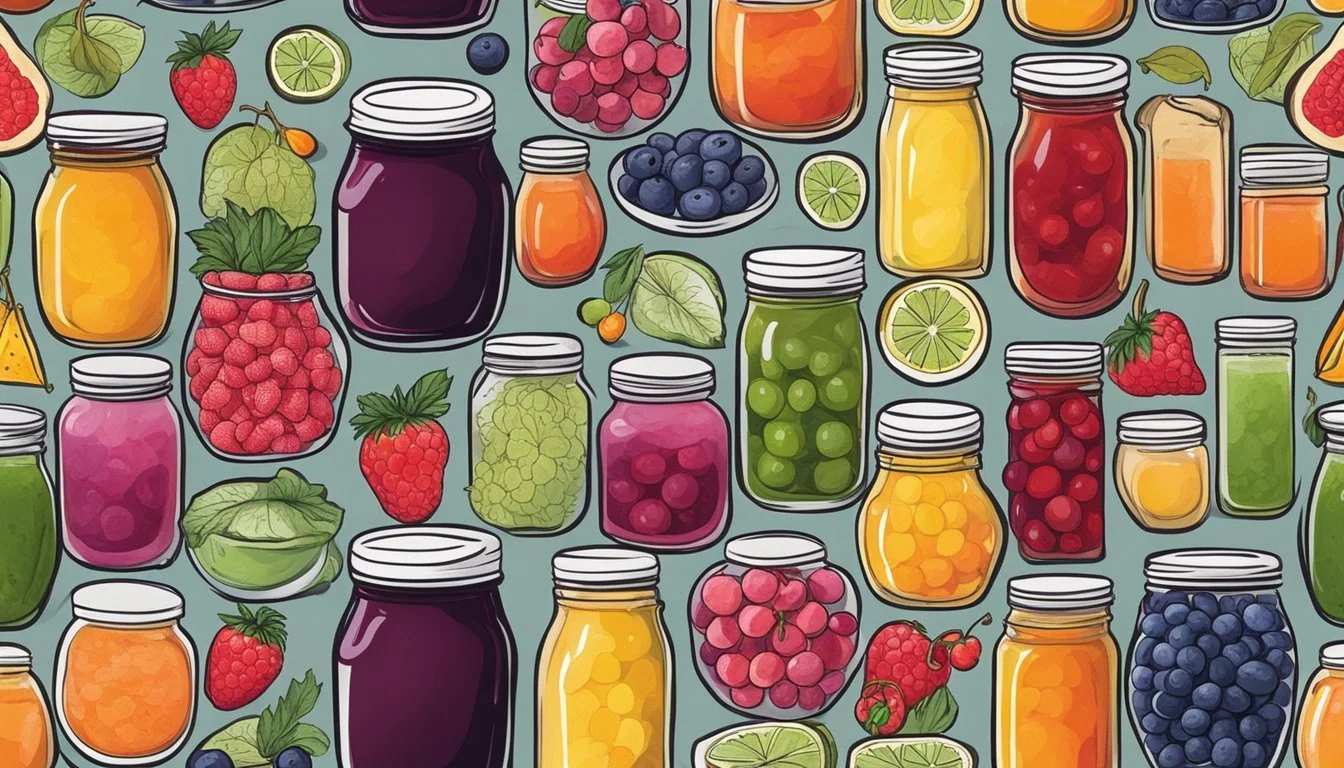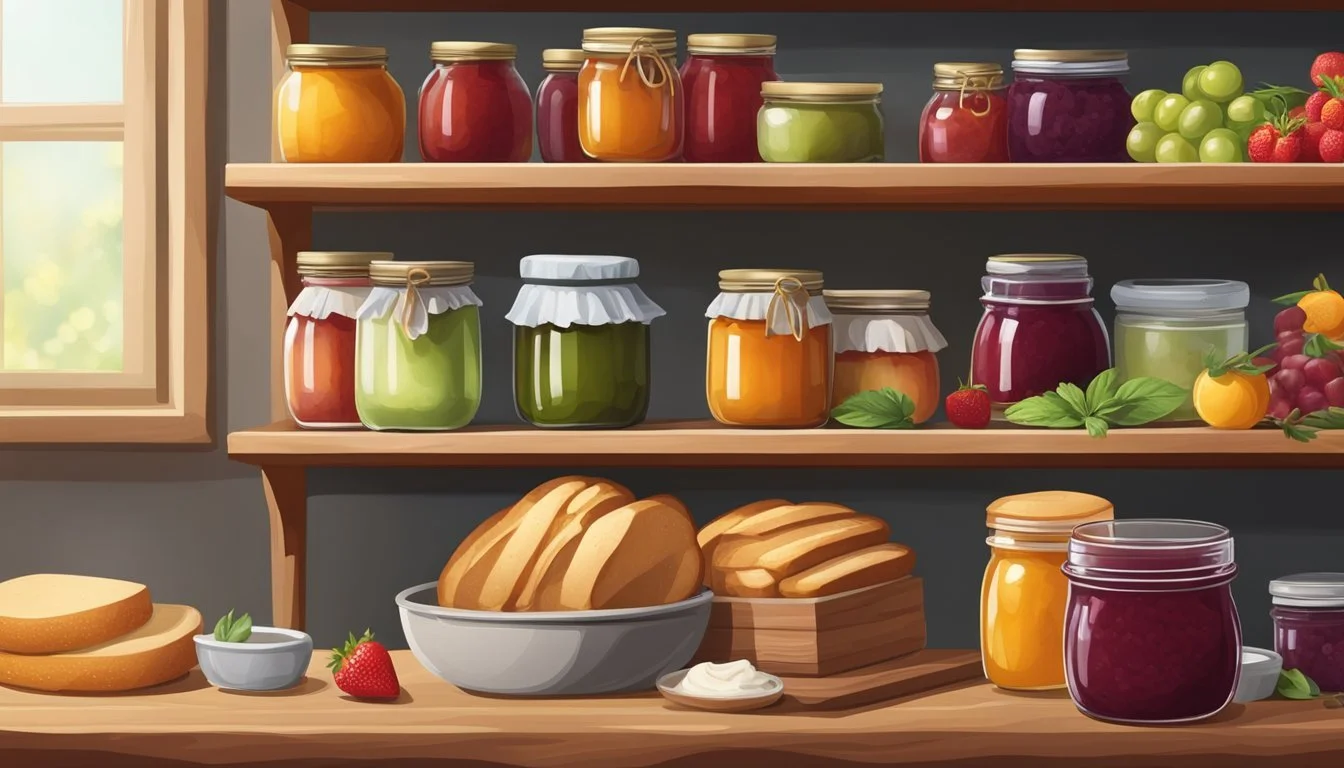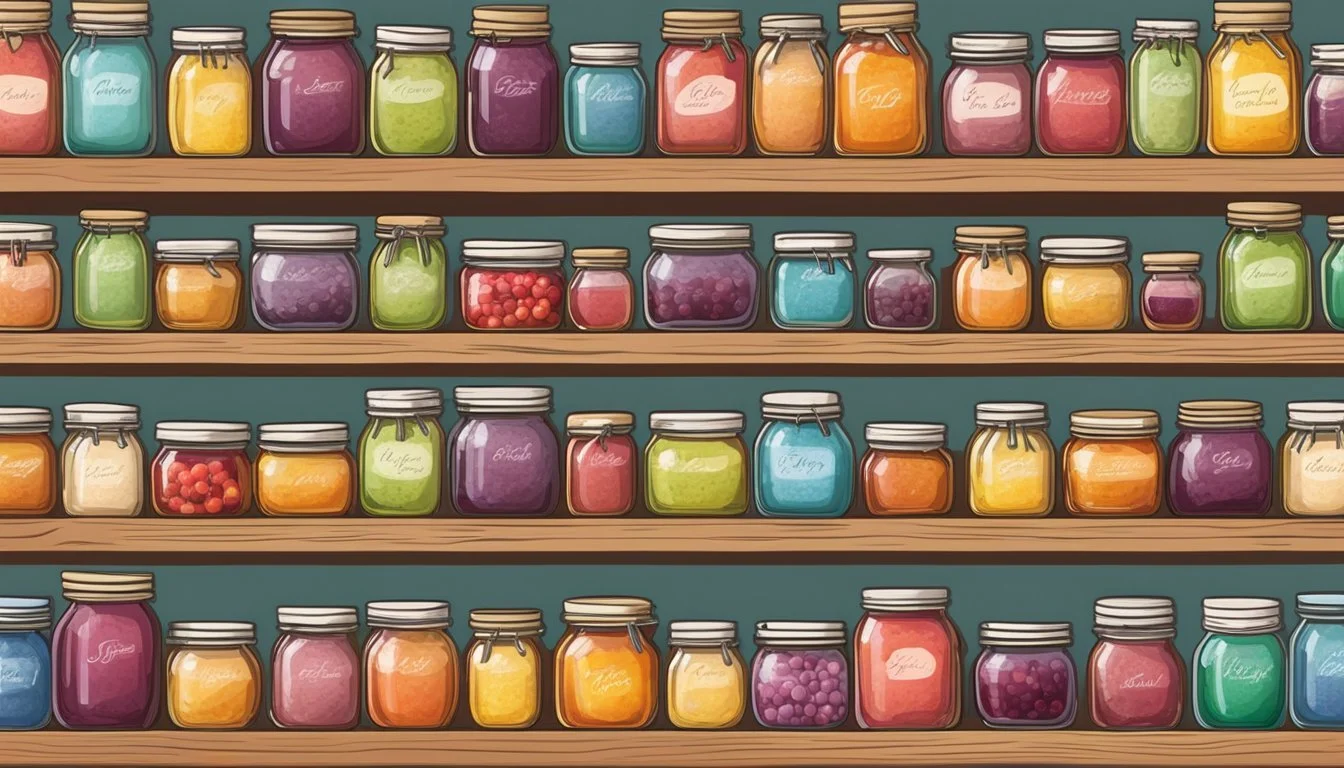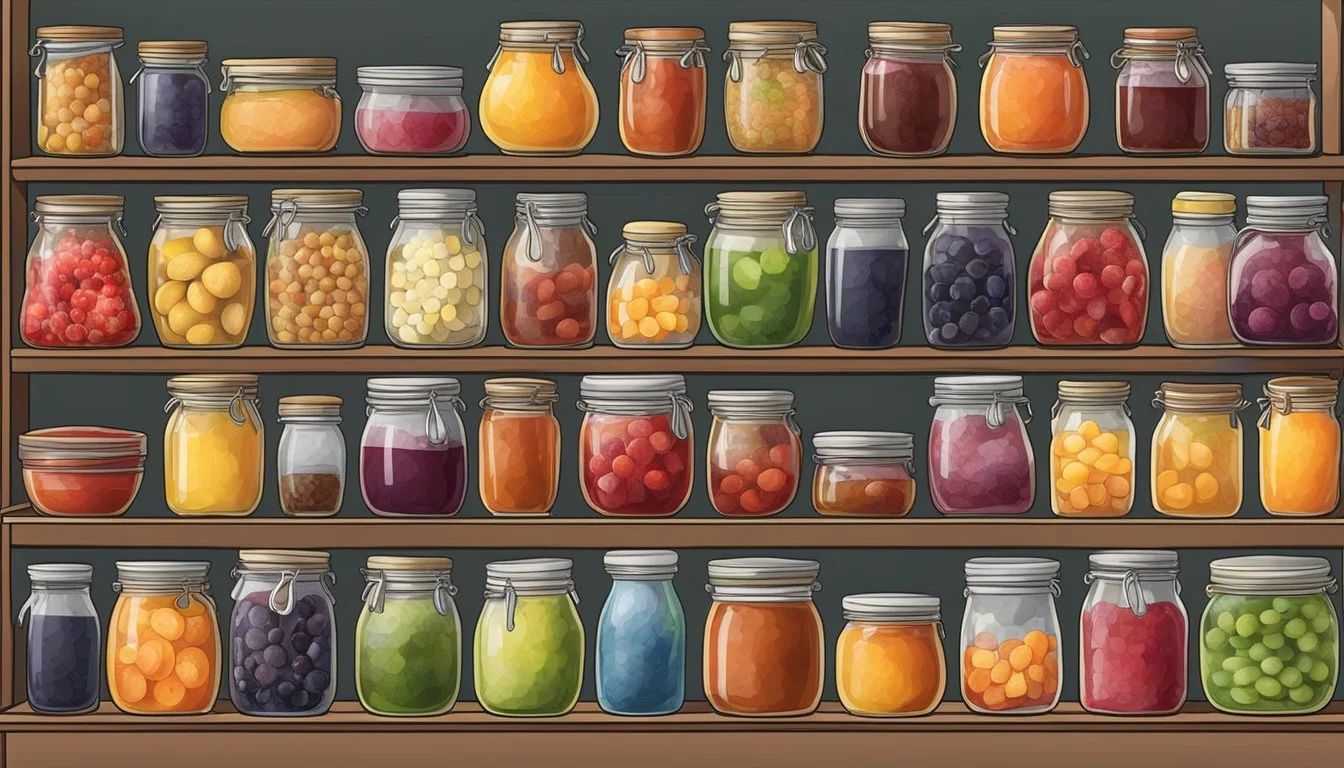Pantry Staple Homemade Jam and Jelly Recipes
Simple Delights from Your Kitchen
Creating jams and jellies at home is a delightful way to transform pantry staples into gourmet treats that capture the essence of fruits and flavors. The art of preserving allows for the enjoyment of seasonal tastes year-round, making homemade jams and jellies not only a practical skill but also a source of personal satisfaction. With a variety of recipes available, one can make everything from classic strawberry jam to unique creations like bourbon peach jam or pomegranate jelly, each packed with natural goodness and devoid of the preservatives found in store-bought versions.
The process of making jams and jellies might seem daunting at first, but it’s quite straightforward and rewarding. Starting with the freshest fruit, adding sugar, and sometimes pectin or lemon juice, these staple ingredients are cooked down to reach the perfect consistency. Some recipes, like those incorporating pectin-rich fruits or using commercial pectin products like Sure-Jell, achieve the desired set with ease. Homemade pantry staple recipes also offer the flexibility to adjust sweetness, avoid allergens, and tailor flavors to individual preferences, ensuring that there's a homemade spread for every palate.
Essentials of Jam and Jelly Making
The creation of jam and jelly is a delightful way to preserve the bounty of the season and have delicious spreads available year-round. Careful consideration of pantry staples, the role of pectin, and the balance of acidity and sugar can greatly influence the quality and flavor of the final product.
Understanding Pantry Staples
To begin making jam or jelly, one must have the necessary ingredients readily available in the pantry. These staples usually include fresh or frozen fruit, sugar, and sometimes commercially available pectin. Jams typically make use of the natural fruit pectin, whereas jellies often rely on added pectin to achieve a firm set.
The Role of Pectin in Gelling
Pectin is crucial for jam and jelly making, as it is the natural substance that causes the mixture to gel when combined with sugar. There are two types of pectin:
High methoxyl (HM): Requires sugar and acid to set.
Low methoxyl (LM): Sets with calcium, no sugar needed.
Most recipes call for HM pectin and the consistency of the jam or jelly will be determined by the proportion of fruit, pectin, and sugar used. Without a proper balance, the spread may be too runny or too stiff.
Importance of Acidity and Sugar
Acidity and sugar are key components in preserving the fruit and achieving the desired consistency and flavor profile of jams and jellies. Acid helps with the gel formation and enhances the fruit's natural flavor. Sugar acts as a preservative, contributes to the gelling process, and affects the overall sweetness. The exact amount of acidity and sugar required can vary depending on the fruit's natural sweetness and pectin levels. It's important to follow recipes closely for successful results.
Popular Jam Varieties
Homemade jams are a delightful way to preserve the essence of fresh fruit flavors. Crafted with care, they include a range of berry and stone fruit jams that are pantry staples in many households.
Strawberry Jam
Strawberry jam is a classic spread with a vibrant red color and a balance of sweetness and acidity. It's made from fresh strawberries, sugar, and often a splash of lemon juice to enhance the flavor. Strawberry jam pairs well with a variety of breakfast foods and desserts.
Blueberry Jam
Blueberry jam offers a slightly tart yet sweet flavor, with a deep, rich blue hue. This jam typically involves simmering blueberries with sugar and can include lemon juice for added brightness. Blueberries contain antioxidants which can contribute to the nutritive value of the jam.
Raspberry Jam
Raspberry jam is known for its intense color and bold, tangy taste. Fresh raspberries are the star ingredient, cooked down with sugar, and occasionally pectin, to achieve a luscious consistency. Raspberry seeds can be strained out for a smoother texture or left in for a more rustic feel.
Blackberry Jam
The robust flavor of blackberry jam comes from the use of plump, juicy blackberries. Preparation involves a simple process of mashing the blackberries with sugar, and the jam often retains the fruit's natural earthy undertones.
Peach Jam
Peach jam captures the essence of summer with its sweet and aromatic qualities. Fresh peaches, peeled and pitted, are reduced with sugar to create a jam that is both succulent and comforting, often with a hint of vanilla or almond to complement the fruit's natural flavor.
Specialty and Unique Jams
Exploring the world of homemade jams reveals a range of unique flavors beyond the classic strawberry or grape. Specialty jams offer a way to enjoy the tastes of various fruits and sometimes unexpected ingredients, each with their own distinct character.
Fig Jam
Fig jam is a luscious spread that holds a deep sweetness, complemented by a subtle hint of natural berry-like flavor. It is often enhanced with lemon juice or zest, bringing a bright note to its rich taste.
Cherry Jam
Cherry jam captures the essence of ripe cherries, delivering a tart yet sweet profile. A simple blend of cherries, sugar, and a touch of citrus juice can elevate the flavor, making it a versatile addition to both sweet and savory dishes.
Tomato Jam
Tomato jam might sound unconventional, but its savory-sweet combination is quite the delight. It is crafted from ripe tomatoes, often paired with seasoning like cinnamon or cloves and a dash of sugar to intensify its inherent tangy sweetness.
Bacon Jam
Bacon jam is for those who savor a smoky, savory spread with a hint of sweetness. Made from cooked down bacon, onions, brown sugar, and sometimes a splash of vinegar, its robust flavor can transform a simple sandwich into a gourmet treat.
Pina Colada Jam
Pina colada jam brings a tropical twist to the breakfast table. This exotic concoction is made from pineapple, coconut, and sometimes a hint of rum flavoring, celebrating the beloved cocktail in a spreadable form.
Homemade Jelly Varieties
Exploring the world of homemade jellies, enthusiasts uncover a range of flavors from the classic to the unexpected. Each variety offers a unique twist to your pantry staples, enriching meals and desserts with new tastes and textures.
Apple Jelly
Apple jelly is a sweet and clear spread, often made from the juice of tart apples for a balance of sweetness and acidity. Typically, apples are simmered to extract their juice and then combined with sugar and lemon juice to set and enhance flavor.
Grape Jelly
Homemade grape jelly starts with the pure juice of concord grapes, favored for their deep, robust flavor. The grapes are cooked down, and the juice extracted, mixed with sugar, and often a touch of lemon juice, until it reaches a perfect, glistening consistency.
Rosemary Jelly
Rosemary jelly introduces a savory twist with its aromatic and herbal notes. This jelly often incorporates the infusion of fresh rosemary leaves into a simple base of fruit juice like apple or grape, complemented by sugar, and sometimes lemon to brighten the flavors.
Green Tomato Jelly
Green tomato jelly showcases the tangy and slightly sweet flavors of unripe tomatoes. This variety adds a zesty profile to the spread selection, commonly using green tomatoes, sugar, and sometimes apple for added sweetness and depth.
Watermelon Jelly
Watermelon jelly is a refreshing and unexpected flavor choice for a homemade jelly. It's crafted from pureed watermelon flesh, strained to a clear juice, combined with sugar, and lemon juice to add a tart contrast to the sweetness of the watermelon.
Each of these homemade jellies reflects an individual character and taste, making them perfect for elevating one's culinary repertoire with both classic and inventive spreads.
Fruit Combinations and Experimental Flavors
In the world of homemade jams and jellies, combining fruits and pushing the envelope with experimental flavors can transform simple spreads into gourmet delights. Traditional fruit pairings get an upgrade, while innovative mixtures offer a unique twist to the breakfast table or cheese platter.
Strawberry Rhubarb Jam
Known for its balance of sweetness and tang, strawberry rhubarb jam is a springtime favorite. Strawberries provide a classic, juicy base, while rhubarb introduces a tart contrast, making it perfect for spreading on morning toast or as a pie filling enhancer.
Apricot Raspberry Jam
The mellow sweetness of apricots blended with the bold tartness of raspberries creates apricot raspberry jam. This jam shines as a filling for pastries or atop pancakes, offering a harmony of flavors that are both bright and deeply satisfying.
Peach Pear Jam
Combining the delicate flavors of peaches with the subtle, sweet notes of pears results in a gently flavored peach pear jam. Its smooth texture and comforting taste make it a delightful addition to warm biscuits or as a glaze for roasted meats (What wine goes well with roasted meats?).
Christmas Jam
Christmas jam is a festive amalgam, typically bringing together cranberries and strawberries with a hint of spice. The result is a vibrant, ruby-red spread that encapsulates the joy of holiday flavors, ideal for gifting or serving alongside holiday treats.
Bam Bam Pomegranate Jam
For the adventurous palate, bam bam pomegranate jam merges the tart punch of pomegranate with a hint of citrus or chili for an unexpected flavor explosion. It commands attention when dolloped over cream cheese for a crowd-pleasing appetizer or used as a glaze to elevate poultry dishes.
Each jam variant presents its own universe of flavor possibilities, inviting both the seasoned jam-maker and the curious beginner to explore and enjoy the craft of homemade jam and jelly creation.
Pantry Complements to Jam and Jelly
Crafting the perfect pantry means ensuring you have the right pairings for your homemade jams and jellies. This section explores the most fitting complements to elevate these fruity spreads.
Homemade Bread for Spreading
For a truly artisan experience, homemade bread serves as the ideal canvas for any variety of jam or jelly. The satisfaction of slathering a warm slice of fresh bread with a sweet, fruity spread cannot be overstated. Breads like sourdough or whole grain are hearty options that enhance the texture and flavor interplay.
Butter and Nut Butter Enhancements
A layer of butter on bread, partnered with jam or jelly, melds rich creaminess with sweet and tart fruitiness. When one chooses a nut butter, such as almond or peanut butter, the combination introduces a delectable contrast of savory nuttiness with the preserve's sweetness. Here's a simple guide for pairing:
Butter: Classic, unsalted butter works with any jam or jelly.
Peanut Butter: Pairs well with grape and strawberry jams.
Almond Butter: Complements berry jellies beautifully.
Jam as Dessert Toppings
Jams and jellies are not limited to toast; they make superb dessert toppings. A dollop of grape jam can transform plain yogurt into a gourmet experience or a spoonful of cherry preserve can add depth to simple vanilla ice cream. Homemade jams add a personal, flavorful touch to everyday desserts.
Usage in Meals and Pairings
In the versatile world of jams and jellies, these flavorful additions are not limited to topping toast or filling pastries. One can incorporate these sweet and zesty condiments into various elements of a meal, from salad dressings to robust sauces, enhancing dishes with depth and brightness.
Salad Dressings and Vinaigrettes
Jams and jellies are excellent emulsifiers for salad dressings and vinaigrettes. They add a hint of sweetness and can help balance the acidity in dressings. A classic example of this would be a raspberry jam vinaigrette where the preserves blend with vinegar and oil to create a harmony of flavors ideal for a mixed green salad or a spinach and goat cheese salad.
Ingredients: Raspberry jam, balsamic vinegar, olive oil, mustard, salt, and pepper.
Method: Whisk together or blend for a smooth consistency.
Marinara Sauce and Substitutes
Unconventionally, one can use fruit-based spreads such as fig or apricot jam to add unexpected sweetness and complexity to marinara sauce or its substitutes. Tomato-based sauces (What wine goes well with tomato-based sauces?) benefit from the subtle fruity undertones; they round out the acidity of the tomatoes while imparting a richer, more complex flavor profile.
Suggestion: Incorporate a tablespoon of apricot jam into a basic marinara sauce for a nuanced twist.
Sweet and Savory Sauces
Jams and jellies can serve as a base for both sweet and savory sauces, pairing especially well with meats like pork and chicken. A common preparation involves creating a glaze or BBQ sauce, which uses the sweetness of the jelly to contrast the savory and spicy elements of the dish.
Recipe Idea: A bourbon peach jam can be transformed into a glaze by adding garlic, soy sauce, and a hint of chili for a sweet and spicy kick.
Homemade Kitchen Staples Beyond Jam
Creating a range of homemade kitchen staples allows one to control the ingredients for a healthier, more personalized diet. This section provides a guide to making dairy products, condiments, and snacks in your own kitchen.
DIY Dairy Products
Homemade Buttermilk
Traditional: Shake heavy cream until it separates into butter and buttermilk.
Substitute: Mix whole milk with lemon juice for an instant buttermilk alternative.
Homemade Butter
Simply churn heavy cream using a stand mixer or by hand shaking until it solidifies into butter and yields leftover buttermilk.
Condiments and Flavor Enhancers
Homemade Mayonnaise
Whisk together egg yolks, oil, and a dash of vinegar or lemon juice. A pinch of salt and a little mustard can add to the flavor.
Hot Sauce
Blend fresh or fermented chilies with garlic, vinegar, and salt. Adjust the ingredients to taste and strain for a smoother texture.
Savory Snack Creations
Homemade Potato Chips
Thinly slice potatoes, toss with olive oil and salt, and bake until crispy. One can also experiment with different seasonings such as paprika or rosemary.
Storing and Preserving Your Creations
When preserving homemade jams and jellies, utilizing the correct storage and canning methods ensures the longevity and freshness of these pantry staples. Attentiveness to sealing techniques, the option for freezer storage, and understanding shelf life can impact both taste and budget.
Canning and Sealing Techniques
Proper canning begins with sterilized jars and lids to prevent contamination. The process involves:
Filling: Ladle the jam or jelly into jars, leaving appropriate head space.
Sealing: Apply lids and screw bands until fingertip tight.
The jars are then processed in a boiling water bath, which creates a vacuum seal that can protect the preserves for up to a year unopened when stored in a cool, dark place.
Freezer Jams for Longevity
Freezer jams offer an alternative for those seeking to avoid the traditional canning process. For freezer jams:
Prepare jam as per the recipe but with a specific pectin for freezer jam.
Allow the jam to sit for the set time to thicken.
Transfer to freezer-safe containers, leaving space at the top for expansion.
These jams can be stored in the freezer for up to a year and in the refrigerator for several weeks once thawed.
Shelf Life and Storage Tips
Understanding the shelf life of homemade preserves is crucial for maintaining quality. Here is a breakdown:
Storage Condition Unopened Opened Pantry (cool, dark place) 6-12 months N/A Refrigerator (after opening) N/A 1-3 months
To ensure maximum quality, always label jars with the date of production. Inspect for signs of spoiling, such as mold or off-odors, before consumption.
Cost-Effective Jam Making
Creating jams and jellies can be highly economical, especially when focusing on using budget-friendly ingredients, preparing in bulk, and utilizing home-grown produce. These strategies can significantly lower the cost per jar, making homemade jam not only a flavorful choice but also a financially wise one.
Budget-Friendly Ingredients
Budget-conscious jam makers should prioritize inexpensive fruits and simple supplies. Staples such as sugar and lemon juice often play a key role in jam-making and can be bought in larger quantities for a lower unit price. For example, jams like Easy Grape Jam often call for common, less expensive ingredients:
Seedless Grapes
Sugar
Lemon Juice
Additionally, seasonal fruits can be more affordable; strawberries often have reduced prices in the spring and early summer, while rhubarb prices drop during peak harvest times.
Tips for Bulk Preparation
Bulk preparation not only saves time but also reduces costs. Buying ingredients in larger quantities can lower the price point, and making multiple batches at once conserves energy. Here are some specific tips for bulk jam preparation:
Cook multiple batches simultaneously if possible.
Use larger pots to combine several recipes into one.
Sterilize jars in batches to save on water and heat.
Utilizing Home-Grown Produce
Home-grown fruits such as strawberries and rhubarb translate to substantial savings in jam production. Gardeners can harvest and use their fresh produce, which eliminates the cost of buying fruit and ensures peak freshness and flavor. Here's how one can utilize home-grown produce for jam making:
Harvest strawberries and rhubarb at their ripest for the best natural pectin content and flavor.
Freeze surplus fruits during the harvest season for use in off-season jam-making sessions.
Preserve the character of a home garden by creating unique blends, like a Strawberry Rhubarb Jam, capitalizing on available produce.
Navigating Dietary Restrictions
In creating homemade jams and jellies, it is important to consider various dietary restrictions to cater to different needs such as sugar content, vegan and gluten-free options, and allergen concerns.
Sugar-Free and Low-Sugar Options
Individuals monitoring their sugar intake can opt for sugar-free pectins that allow jams and jellies to set without added sugar. Alternative sweeteners like stevia, erythritol, or xylitol can be used to taste. It is critical to follow specific recipes designed for these sweeteners, as the usual sugar to fruit ratios will not apply.
Table 1: Sugar Substitutes for Jams and Jellies
Substitute Sweetness Relative to Sugar Notes Stevia 200-300 times sweeter Use sparingly; may have aftertaste Erythritol 70% as sweet as sugar Measures cup for cup; non-glycemic Xylitol Similar sweetness to sugar Toxic to pets; has a cooling effect
Vegan and Gluten-Free Recipes
For those adhering to vegan diets, ensure there are no animal products used, such as gelatin, which is traditionally found in some pectin blends. Opt for fruit-pectin brands that are explicitly labeled vegan-friendly. Additionally, most jams and jellies are inherently gluten-free, as they do not contain flour or other gluten-containing ingredients. However, always check for any cross-contamination risks if you are highly sensitive or have celiac disease.
Allergen Considerations
Jams and jellies may include common allergens such as fruits (strawberries, cherries) or nuts (used in some recipes for texture). Clearly labeling homemade preserves with all ingredients can greatly minimize the risk of allergic reactions. Always use clean utensils and equipment to avoid cross-contamination with allergens.
Labeling tips:
List all ingredients in order of quantity.
Highlight potential allergens in bold.
Creative Uses for Leftover Ingredients
When it comes to utilizing leftover pantry staples, practical creativity can transform them into indulgent treats, flavorful enhancements, and even the base of savory sauces. Here's how one can repurpose bread, flour, brown sugar, breadcrumbs, seasoning mix, and gravy into delightful culinary creations.
Baked Goods and Desserts
With leftover bread, a chef can easily whip up a classic Bread Pudding, enriching it with various jams for added sweetness and flavor. Flour and brown sugar are the beginning of many dessert recipes, from crumbly streusel toppings to thickening agents for fruit pie fillings. Those with a penchant for baking can explore different jam-infused cookies, such as thumbprint cookies with a dollop of their favourite preserve.
Thumbprint Cookies:
Ingredients: Flour, brown sugar, butter, jam
Instructions: Create dough, form indentations, bake, and fill with jam.
Bread Pudding:
Ingredients: Stale bread, milk, eggs, sugar, jam
Instructions: Cube bread, mix wet ingredients, bake with dollops of jam.
Homemade Seasoning Blends
Transform plain breadcrumbs into a homemade seasoning mix by adding dried herbs and spices. These seasoned breadcrumbs can be used to coat proteins or sprinkled over casseroles for a crispy finish, introducing a new layer of texture and flavor to the dish.
Seasoned Breadcrumbs:
Ingredients: Breadcrumbs, dried herbs, spices
Uses: Coating for meats or crispy topping for baked dishes
Crafting Homemade Gravy
Incorporate leftover flour and seasoning mixes to craft a robust homemade gravy. One starts by making a roux with flour which becomes the base to which liquid and seasonings are added, resulting in a flavorful gravy that can complement various dishes, from meats to potatoes. If there is any leftover gravy, it can be thickened or enhanced with additional flour or seasonings to suit new dishes.
Homemade Gravy:
Base: Roux made from flour and fat
Customization: Add pan drippings, seasoning mix, extra brown sugar for a hint of sweetness
Each ingredient, from bread to gravy, holds potential for culinary experimentation, encouraging both resourcefulness and creativity in the kitchen.








